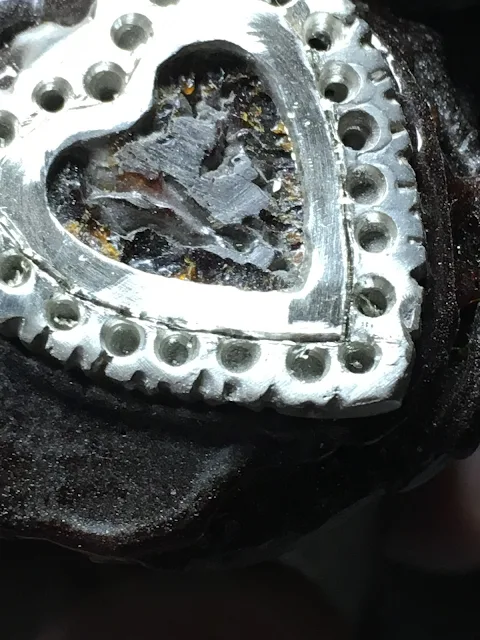Under normal circumstances our CAD "Computer Aided Designing" program might not give us the necessary tools. Therefore 'we' must make our own to suite our specific needs.
In this photo, you can see the 'face' of the graver nestled against the lower right side of the bead.
The main difference between an "Onglette (metal cutting) graver" and the "Beading tool" (also an Onglette graver) is the 'rounding' of the point.
This 'rounding' allows the front of the graver to dig into the metal without breaking the delicate graver point, simple as that!
No matter the graver's length, it still works with the 'adjustable handle'.
The required Emery Paper has a grit of #240; if needed, you can use #400 grit. I prefer the #240 grit, as the blade won't slide along the metal while 'digging in'.
All of my graver blades are of "HSS", aka "High-Speed Steel". The reasoning is that I need a durable blade that won't bend or break in the (aggressive) beading processes.
From a substantial piece of steel, I fashioned a new tool to create new beads.
Underneath the face of the graver point will be my new Bead-Raiser. That section will now be smoothed and rounded on "Emery Paper" of #240 grit.
No matter the length of the graver, all three of them will eventually be used in conjunction with my "Adjustable, Graver Handle".
In using silver as my 'chosen metal', I use it specifically for its softness and being able to make my metal cuttings shine. You can see the first samples of 'Raising Beads'.
Without any new tools, there wouldn't be any method or technique for securing or forming the new beads.
A Bead Raiser tool has just one purpose and that is to move metal over the Girdle of the stone.
You can see how the 'curvature of the blade' as it now looks under my microscope.
This is a #400 power magnification of the course #240 Emery paper. This paper will literally 'round off' the front edge of the blade.
Here is a finer paper that is used to shape the steel blade, it's rated at #600 grit.
It is imperative to have this 'new tool' in our inventory. The "CAD" program is not the only way to set stones, WE MUST THEREFORE IMPROVISE ON OUR METHODS.
Supposing that we have to set gemstones, as shown in the following photos? There is only one solution to this problem and that is to use a "Bead Raiser".
Only after the holes have been enlarged to accept the stones, then the hand-made beads are ready to have the stones put into the metal. I will gladly use my Bead Raiser to "move the metal" over the Girdle of stones.
Each hole must be made larger to accept each stone.
As I always say there are "NOT SHORT-CUTS IN GEMSTONE SETTING" The 'quickest route' is always 'the correct route'.
After each stone is placed into the metal, use your Bead-Raising graver/tool to dig into the metal and tighten every stone where each bead is located.
As you can see all of the metal cutting has been attended to before setting any of the stones.
Is this a difficult process? I think this process is rated at about 7-8 out of 10.





















.JPG)

.jpg)
.jpg)
.jpg)


.jpg)
.jpg)





.jpg)

.jpg)
.jpg)